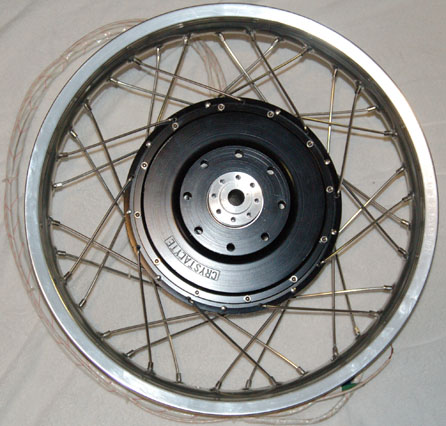Doctorbass
100 GW
Remember this great video ? 
Ashiya University Solar Car Project Sky Ace TIGA variable field magnet motor plot type å¯変界ç£Âモーター
[youtube]6_41btVawMc[/youtube]
I finally found their WEBSITE !! http://www.ashiya-u.ac.jp/solarcar/
Alot of us saw it and was impressed by the variable rotor position from the stator that increase speed.
The motor can controll RPM by controller, also by variable field magnet.
In case RPM is controlled by the controller it self, under the 100% which will have switching loss.
However speed controll by the variable field magnet controlling which does not have any loss even low RPM as controller is alwas 100%.
Because the speed is controlled by variable field magnet.
The known specs are:
MODEL: M15150D ( specially designed for the Sky Ace TIGA Team)
DC brush less variable field magnet in wheel DD [Mitsuba] make
Rating: 2kW (Max 7kW)
Max speed with 140kg solar car: 152kph
Built in July 2000
From now we did motor tuning like Delta-wye, serie parallel and over amp and over volt.. but none of us tried that!!! :wink:
I would be very curious if someone of us could do that.. including me.. :wink:
About the famous video, we know it's a motor that was designed for solar race. It's from the TIGA MITSUBA race team. A chinese or japanese team.
The variable field motor seem made by the Mitsuba company..
I found more video about variable field motor! when searching from their youtube account.
I thought it could be interesting to see if it could be applied to the RC motor many of us like or to our hub motor.
Some video ( some are availlable in HD)
Variable rotor stator alignment on Mitsuba motor (Expt 1)
[youtube]x6u-GebOfRQ[/youtube]
Variable rotor stator alignment on Mitsuba motor (Expt 2)
[youtube]ovtjlJGCo1Y[/youtube]
Variable rotor stator alignment on Mitsuba motor (Expt 3)
[youtube]HiD6amSoVsg[/youtube]
DQB TJSS I
[youtube]YaIwTTpztaI[/youtube]
Venture II Engine Test 2
[youtube]SA7cXzEVW0I[/youtube]
Venture II Engine Test
[youtube]jUrSaKDLI4k[/youtube]
The Solar Car Racing Motor of Mitsuba M2096 2009 ver Video 2
[youtube]V-eoEHjc65w[/youtube]
The channel of mnmsmushy:
http://www.youtube.com/user/mnmsmushy#p/u/9/HiD6amSoVsg
The channel of ngjyang86
http://www.youtube.com/watch?v=ovtjlJGCo1Y&feature=related
The channel of nomnom13's
http://www.youtube.com/user/nomnom13#p/u/4/zLc2nYs7SKw
Now something quite different: Russian ultra efficient magnet motor
[youtube]L1rilJFviVM[/youtube]
Doc
Ashiya University Solar Car Project Sky Ace TIGA variable field magnet motor plot type å¯変界ç£Âモーター
[youtube]6_41btVawMc[/youtube]
I finally found their WEBSITE !! http://www.ashiya-u.ac.jp/solarcar/
Alot of us saw it and was impressed by the variable rotor position from the stator that increase speed.
The motor can controll RPM by controller, also by variable field magnet.
In case RPM is controlled by the controller it self, under the 100% which will have switching loss.
However speed controll by the variable field magnet controlling which does not have any loss even low RPM as controller is alwas 100%.
Because the speed is controlled by variable field magnet.
The known specs are:
MODEL: M15150D ( specially designed for the Sky Ace TIGA Team)
DC brush less variable field magnet in wheel DD [Mitsuba] make
Rating: 2kW (Max 7kW)
Max speed with 140kg solar car: 152kph
Built in July 2000
From now we did motor tuning like Delta-wye, serie parallel and over amp and over volt.. but none of us tried that!!! :wink:
I would be very curious if someone of us could do that.. including me.. :wink:
About the famous video, we know it's a motor that was designed for solar race. It's from the TIGA MITSUBA race team. A chinese or japanese team.
The variable field motor seem made by the Mitsuba company..
I found more video about variable field motor! when searching from their youtube account.
I thought it could be interesting to see if it could be applied to the RC motor many of us like or to our hub motor.
Some video ( some are availlable in HD)
Variable rotor stator alignment on Mitsuba motor (Expt 1)
[youtube]x6u-GebOfRQ[/youtube]
Variable rotor stator alignment on Mitsuba motor (Expt 2)
[youtube]ovtjlJGCo1Y[/youtube]
Variable rotor stator alignment on Mitsuba motor (Expt 3)
[youtube]HiD6amSoVsg[/youtube]
DQB TJSS I
[youtube]YaIwTTpztaI[/youtube]
Venture II Engine Test 2
[youtube]SA7cXzEVW0I[/youtube]
Venture II Engine Test
[youtube]jUrSaKDLI4k[/youtube]
The Solar Car Racing Motor of Mitsuba M2096 2009 ver Video 2
[youtube]V-eoEHjc65w[/youtube]
The channel of mnmsmushy:
http://www.youtube.com/user/mnmsmushy#p/u/9/HiD6amSoVsg
The channel of ngjyang86
http://www.youtube.com/watch?v=ovtjlJGCo1Y&feature=related
The channel of nomnom13's
http://www.youtube.com/user/nomnom13#p/u/4/zLc2nYs7SKw
Now something quite different: Russian ultra efficient magnet motor
[youtube]L1rilJFviVM[/youtube]
Doc







